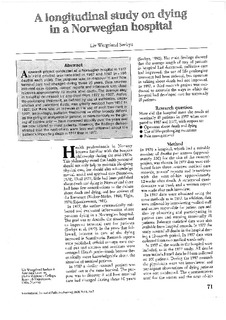| dc.contributor.author | Sørbye, Liv Wergeland | |
| dc.date.accessioned | 2007-12-17T09:41:57Z | |
| dc.date.issued | 2000 | |
| dc.identifier.issn | 1357-6321 | |
| dc.identifier.uri | http://hdl.handle.net/11250/98787 | |
| dc.description.abstract | A research project conducted at a Norwegian hospital in 1977 (n=213 deaths) was repeated in 1987 and 1997 (n=100 deaths each year). The purpose was to discover if and how terminal care had changed during these 20 years. Data sources included case records, nurses’ reports and interviews with close relatives approximately 12 weeks after death. The average stay in hospital decreased by one-third from 1977 to 1997. Active life-prolonging treatment, as defined by use of antibiotics, resuscitation and parenteral fluids, was greatly reduced from 1977 to 1987, but there was an increase in the use of such treatment in 1997. Interestingly, palliative treatments — either broadly defined as the giving of analgesics in general, or more narrowly as the giving of opiates only — have increased steadily over the years and are now offered to most patients. However, the findings demonstrated that the next-of-kin were less well informed about the patient’s impending death in 1997 than in 1977. | en |
| dc.format.extent | 5009951 bytes | |
| dc.format.mimetype | application/pdf | |
| dc.language.iso | eng | en |
| dc.publisher | Mark Allen | en |
| dc.subject | life-prolonging treatment | en |
| dc.subject | livsforlengende behandling | en |
| dc.subject | palliativ behandling | en |
| dc.subject | smertelindring | en |
| dc.subject | pain relief | en |
| dc.subject | death | en |
| dc.subject | døden | en |
| dc.subject | pårørende | en |
| dc.subject | relatives | en |
| dc.subject | terminalpleie | en |
| dc.subject | terminal care | en |
| dc.subject | vitenskapelig (fagfellevurdert) | en |
| dc.title | A longitudinal study on dying in a Norwegian hospital | en |
| dc.type | Journal article | en |
| dc.type | Peer reviewed | |
| dc.source.pagenumber | 71-72, 74-79 (8 s.) | en |
| dc.source.volume | 6 | en |
| dc.source.journal | International Journal of Palliative Nursing | en |
| dc.source.issue | 2 | en |
